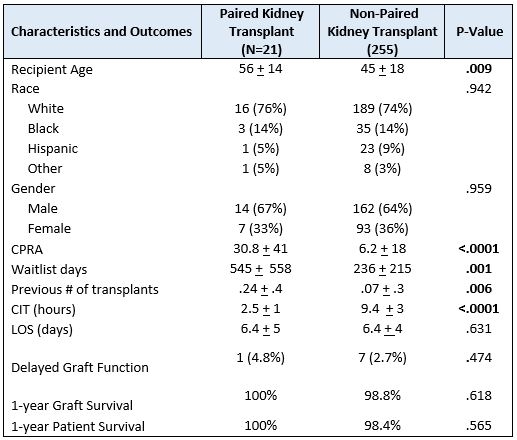Unique Recipient Benefits with Paired Kidney Donation
J. Buggs,1 E. Rogers,2 V. Bowers.1
1Transplant Surgery, Tampa General Medical Group, Tampa General Hospital, Tampa, FL
2Transplant Research, Tampa General Hospital, Tampa, FL.
Meeting: 2018 American Transplant Congress
Abstract number: A160
Keywords: Donors, Kidney transplantation, Outcome, unrelated
Session Information
Session Name: Poster Session A: Kidney Paired Exchange
Session Type: Poster Session
Date: Saturday, June 2, 2018
Session Time: 5:30pm-7:30pm
 Presentation Time: 5:30pm-7:30pm
Presentation Time: 5:30pm-7:30pm
Location: Hall 4EF
Introduction: Kidney transplantation is the treatment choice for ESRD with improved survival and cost benefit compared with dialysis. The imbalance of supply over demand along with ABO incompatibility has compelled expansion of the living donor pool to include the use of paired kidney donation (PKD). Hypothesis: We hypothesized the utilization of PKD has added unique recipient benefits over non-paired kidney donation (Non-PKD). Methods: We conducted a retrospective cohort study of all consecutive living (PKD and Non-PKD) kidney transplants (KT) performed at our center from January 2011 through November 2016. The difference in continuous variables across compared groups was assessed using Mann-Whitney U test and for binary variables using chi-square test. Kaplan Meier with the log-rank test was used for time to event analysis. Statistical significance was set at 5% for all comparisons. Results: There were 276 living kidney transplants performed (21 PKD and 255 Non-PKD). The mean recipient age in years was 56.3 for PKD and 45.5 for Non-PKD, P=.009. The CIT in hours was 9.4 for PKD vs. 2.5 for non-PKD, P<.0001.The mean days on waitlist was 545.3 for PKD and 235.9 for Non-PKD, P=.001. The mean CPRA for PKD was 30.8% vs. 6.2% for non-PKD, P<.0001.The mean number of previous KT was 0.24 for PKD vs. 0.07 for Non-PKD, P=.006. There was no statistical difference in LOS, DGF, discharge creatinine, patient survival or graft survival between PKD and Non-PKD groups.
Conclusion: Our results indicate paired kidney donation provided a statistically significant means of expanding the organ donor pool for older recipients, prior kidney transplant recipients, and kidney transplant recipients with a higher CPRA. Utilization of paired kidney donation at our center demonstrated one-year patient and graft survival rates equivalent with non-paired kidney transplant recipients. Our findings are limited as a single center and warrant further multi-center investigation.
CITATION INFORMATION: Buggs J., Rogers E., Bowers V. Unique Recipient Benefits with Paired Kidney Donation Am J Transplant. 2017;17 (suppl 3).
To cite this abstract in AMA style:
Buggs J, Rogers E, Bowers V. Unique Recipient Benefits with Paired Kidney Donation [abstract]. https://atcmeetingabstracts.com/abstract/unique-recipient-benefits-with-paired-kidney-donation/. Accessed December 25, 2025.« Back to 2018 American Transplant Congress

